Shure orporated BLX1W Wireless Microphone Transmitter User Manual Exhibit D Users Manual per 2 1033 c3
Shure Incorporated Wireless Microphone Transmitter Exhibit D Users Manual per 2 1033 c3
Exhibit D Users Manual per 2 1033 c3
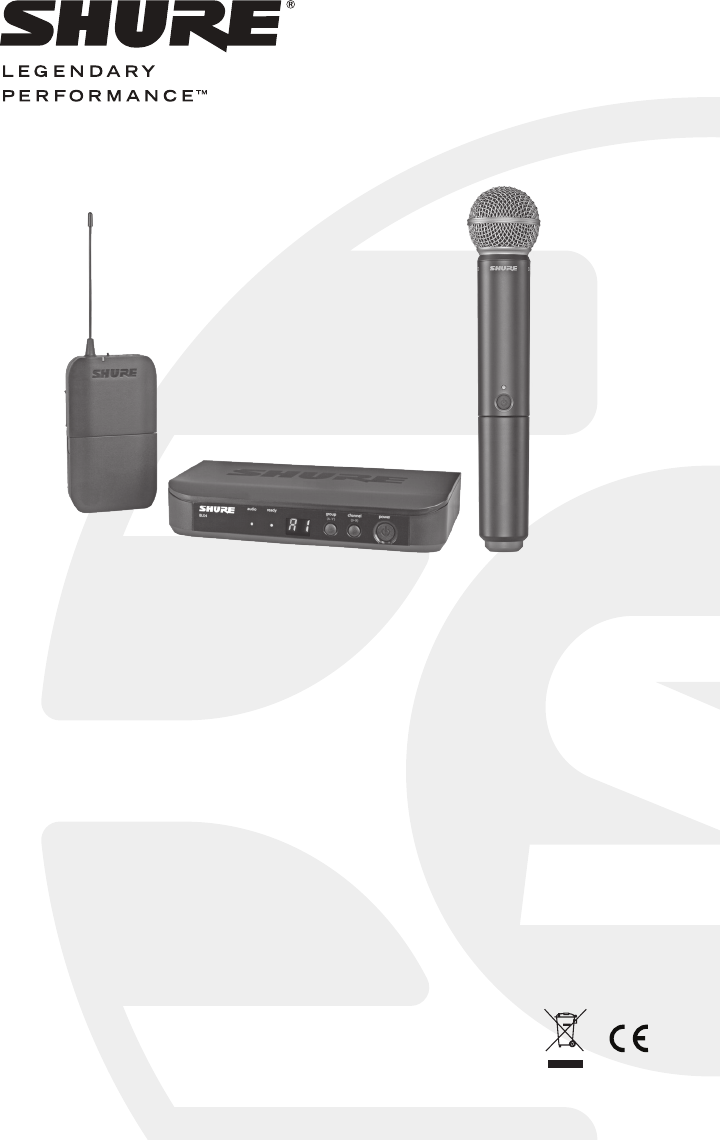
BLX Wireless Microphone System
Système de microphone sans fil BLX
Sistema de micrófonos inalámbricos BLX
Sistema de Microfone Sem Fio BLX
*27A16033*
©2015 Shure Incorporated
27A16033 (Rev. 6)

CONSIGNES DE SÉCURITÉ IMPORTANTES
1. LIRE ces consignes.
2. CONSERVER ces consignes.
3. OBSERVER tous les avertissements.
4. SUIVRE toutes les consignes.
5. NE PAS utiliser cet appareil à proximité de l'eau.
6. NETTOYER UNIQUEMENT avec un chiffon sec.
7. NE PAS obstruer les ouvertures de ventilation. Laisser des distances suffisantes pour
permettre une ventilation adéquate et effectuer l'installation en respectant les instructions
du fabricant.
8. NE PAS installer à proximité d'une source de chaleur telle qu'une flamme nue, un
radiateur, une bouche de chaleur, un poêle ou d'autres appareils (dont les amplificateurs)
produisant de la chaleur. Ne placer aucune source à flamme nue sur le produit.
9. NE PAS détériorer la sécurité de la fiche polarisée ou de la fiche de terre. Une fiche
polarisée comporte deux lames dont l'une est plus large que l'autre. Une fiche de terre
comporte deux lames et une troisième broche de mise à la terre. La lame la plus large ou
la troisième broche assure la sécurité de l'utilisateur. Si la fiche fournie ne s'adapte pas à
la prise électrique, demander à un électricien de remplacer la prise hors normes.
10. PROTÉGER le cordon d'alimentation afin que personne ne marche dessus et que rien ne
le pince, en particulier au niveau des fiches, des prises de courant et du point de sortie
de l'appareil.
11. UTILISER UNIQUEMENT les accessoires spécifiés par le fabricant.
12. UTILISER uniquement avec un chariot, un pied, un trépied, un support ou
une table spécifié par le fabricant ou vendu avec l'appareil. Si un chariot
est utilisé, déplacer l'ensemble chariot-appareil avec précaution afin de ne
pas le renverser, ce qui pourrait entraîner des blessures.
13. DÉBRANCHER l'appareil pendant les orages ou quand il ne sera pas utilisé pendant
longtemps.
14. CONFIER toute réparation à du personnel qualifié. Des réparations sont nécessaires
si l'appareil est endommagé d'une façon quelconque, par exemple : cordon ou prise
d'alimentation endommagé, liquide renversé ou objet tombé à l'intérieur de l'appareil,
exposition de l'appareil à la pluie ou à l'humidité, appareil qui ne marche pas normale-
ment ou que l'on a fait tomber.
15. NE PAS exposer cet appareil aux égouttures et aux éclaboussements. NE PAS poser
des objets contenant de l'eau, comme des vases, sur l'appareil.
16. La prise SECTEUR ou un coupleur d’appareil électrique doit rester facilement utilisable.
17. Le bruit aérien de l'appareil ne dépasse pas 70 dB (A).
18. L'appareil de construction de CLASSE I doit être raccordé à une prise SECTEUR dotée
d'une protection par mise à la terre.
19. Pour réduire les risques d'incendie ou de choc électrique, ne pas exposer cet appareil à
la pluie ou à l'humidité.
20. Ne pas essayer de modifier ce produit. Cela risque de causer des blessures et/ou la
défaillance du produit.
21. Utiliser ce produit dans sa plage de températures de fonctionnement spécifiée.
Ce symbole indique la présence d'une tension dangereuse dans
l'appareil constituant un risque de choc électrique.
Ce symbole indique que la documentation fournie avec l'appareil con-
tient des instructions d'utilisation et d'entretien importantes.
IMPORTANTES INSTRUÇÕES DE SEGURANÇA
1. LEIA estas instruções.
2. GUARDE estas instruções.
3. PRESTE ATENÇÃO a todas as instruções.
4. SIGA todas as instruções.
5. NÃO use este aparelho perto de água.
6. LIMPE SOMENTE com um pano seco.
7. NÃO bloqueie nenhuma das aberturas de ventilação. Deixe distâncias suficientes para
ventilação adequada e instale de acordo com as instruções do fabricante.
8. NÃO instale próximo de nenhuma fonte de calor, tais como fogo aceso, radiadores,
bocais de aquecimento, fornos ou outros aparelhos que produzam calor (inclusive ampli-
ficadores). Não coloque fontes de chamas sobre o produto.
9. NÃO inutilize as características de segurança do conector polarizado ou com pino de
aterramento. Um conector polarizado possui duas lâminas com uma mais larga do que a
outra. Um conector com pino de aterramento possui duas lâminas e um terceiro pino de
aterramento. É fornecida uma lâmina mais larga ou o terceiro pino para a sua segurança.
Se por acaso o conector não se encaixar na tomada, chame um eletricista para substituir
a tomada obsoleta.
10. PROTEJA o cabo de alimentação, evitando que seja pisado ou que enrosque, especial-
mente nos conectores, nas tomadas elétricas de emprego geral e no ponto onde elas
saem do aparelho.
11. USE SOMENTE acessórios/apetrechos especificados pelo fabricante.
12. USE somente com um carrinho, pedestal, tripé, suporte ou mesa espe-
cificados pelo fabricante ou vendidos com o aparelho. Quando utilizar um
carrinho, tenha cuidado ao movimentar o conjunto aparelho/carrinho para
evitar danos com a queda do mesmo.
13. DESLIGUE este aparelho da tomada elétrica durante tempestades com relâmpagos ou
quando não seja utilizado por longo período.
14. DEIXE toda a manutenção sob a responsabilidade de uma equipe de manutenção
qualificada. É necessário realizar a manutenção quando por algum motivo o aparelho
tiver sido danificado de alguma forma, como por exemplo por dano do cabo de alimen-
tação elétrica ou do seu conector, por derramamento de líquido ou queda de objetos no
aparelho, se o aparelho tiver sido exposto à chuva ou à umidade, não esteja operando
normalmente ou tenha sofrido queda.
15. NÃO exponha o aparelho a respingos ou goteiras. NÃO coloque objetos cheios de
líquidos, tais como vasos, sobre o aparelho.
16. O plugue MAINS (rede elétrica) ou um acoplador de aparelho deve estar sempre pronto
para operação.
17. O ruído aéreo do Aparelho não ultrapassa 70 dB (A).
18. O aparelho com construção CLASSE I deve estar conectado à tomada da rede elétrica
com ligação à terra.
19. Para reduzir o risco de incêndio ou choque elétrico, não exponha este aparelho à chuva
ou umidade.
20. Não tente alterar este produto. Isso poderá resultar em lesão pessoal e/ou falha do
produto.
21. Opere este produto dentro da faixa de temperatura de operação especificada.
Este símbolo indica que existe nesta unidade tensão perigosa que
apresenta risco de choque elétrico.
Este símbolo indica que existem instruções operação e manutenção
importantes na literatura que acompanha esta unidade.
IMPORTANT SAFETY INSTRUCTIONS
1. READ these instructions.
2. KEEP these instructions.
3. HEED all warnings.
4. FOLLOW all instructions.
5. DO NOT use this apparatus near water.
6. CLEAN ONLY with dry cloth.
7. DO NOT block any ventilation openings. Allow sufficient distances for adequate ventila-
tion and install in accordance with the manufacturer’s instructions.
8. DO NOT install near any heat sources such as open flames, radiators, heat registers,
stoves, or other apparatus (including amplifiers) that produce heat. Do not place any open
flame sources on the product.
9. DO NOT defeat the safety purpose of the polarized or groundingtype plug. A polarized
plug has two blades with one wider than the other. A grounding type plug has two blades
and a third grounding prong. The wider blade or the third prong are provided for your
safety. If the provided plug does not fit into your outlet, consult an electrician for replace-
ment of the obsolete outlet.
10. PROTECT the power cord from being walked on or pinched, particularly at plugs, conve-
nience receptacles, and the point where they exit from the apparatus.
11. ONLY USE attachments/accessories specified by the manufacturer.
12. USE only with a cart, stand, tripod, bracket, or table specified by the manu-
facturer, or sold with the apparatus. When a cart is used, use caution when
moving the cart/apparatus combination to avoid injury from tip-over.
13. UNPLUG this apparatus during lightning storms or when unused for long
periods of time.
14. REFER all servicing to qualified service personnel. Servicing is required when the ap-
paratus has been damaged in any way, such as power supply cord or plug is damaged,
liquid has been spilled or objects have fallen into the apparatus, the apparatus has been
exposed to rain or moisture, does not operate normally, or has been dropped.
15. DO NOT expose the apparatus to dripping and splashing. DO NOT put objects filled with
liquids, such as vases, on the apparatus.
16. The MAINS plug or an appliance coupler shall remain readily operable.
17. The airborne noise of the Apparatus does not exceed 70dB (A).
18. Apparatus with CLASS I construction shall be connected to a MAINS socket outlet with a
protective earthing connection.
19. To reduce the risk of fire or electric shock, do not expose this apparatus to rain or
moisture.
20. Do not attempt to modify this product. Doing so could result in personal injury and/or
product failure.
21. Operate this product within its specified operating temperature range.
This symbol indicates that dangerous voltage constituting a risk of
electric shock is present within this unit.
This symbol indicates that there are important operating and mainte-
nance instructions in the literature accompanying this unit.
WARNING: This product contains a chemical known to the State of California to cause cancer and birth
defects or other reproductive harm.
INSTRUCCIONES IMPORTANTES DE SEGURIDAD
1. LEA estas instrucciones.
2. CONSERVE estas instrucciones.
3. PRESTE ATENCION a todas las advertencias.
4. SIGA todas las instrucciones.
5. NO utilice este aparato cerca del agua.
6. LIMPIE UNICAMENTE con un trapo seco.
7. NO obstruya ninguna de las aberturas de ventilación. Deje espacio suficiente para
proporcionar ventilación adecuada e instale los equipos según las instrucciones del
fabricante.
8. NO instale el aparato cerca de fuentes de calor tales como llamas descubiertas, radiad-
ores, registros de calefacción, estufas u otros aparatos (incluyendo amplificadores) que
produzcan calor. No coloque artículos con llamas descubiertas en el producto.
9. NO anule la función de seguridad del enchufe polarizado o con clavija de puesta a tierra.
Un enchufe polarizado tiene dos patas, una más ancha que la otra. Un enchufe con pu-
esta a tierra tiene dos patas y una tercera clavija con puesta a tierra. La pata más ancha
o la tercera clavija se proporciona para su seguridad. Si el tomacorriente no es del tipo
apropiado para el enchufe, consulte a un electricista para que sustituya el tomacorriente
de estilo anticuado.
10. PROTEJA el cable eléctrico para evitar que personas lo pisen o estrujen, particularmente
en sus enchufes, en los tomacorrientes y en el punto en el cual sale del aparato.
11. UTILICE únicamente los accesorios especificados por el fabricante.
12. UTILICE únicamente con un carro, pedestal, trípode, escuadra o mesa del
tipo especificado por el fabricante o vendido con el aparato. Si se usa un
carro, el mismo debe moverse con sumo cuidado para evitar que se vuelque
con el aparato.
13. DESENCHUFE el aparato durante las tormentas eléctricas, o si no va a ser utilizado por
un lapso prolongado.
14. TODA reparación debe ser llevada a cabo por técnicos calificados. El aparato requiere
reparación si ha sufrido cualquier tipo de daño, incluyendo los daños al cordón o enchufe
eléctrico, si se derrama líquido sobre el aparato o si caen objetos en su interior, si ha sido
expuesto a la lluvia o la humedad, si no funciona de modo normal, o si se ha caído.
15. NO exponga este aparato a chorros o salpicaduras de líquidos. NO coloque objetos
llenos con líquido, tales como floreros, sobre el aparato.
16. El enchufe de alimentación o un acoplador para otros aparatos deberá permanecer en
buenas condiciones de funcionamiento.
17. El nivel de ruido transmitido por el aire del aparato no excede de 70 dB(A).
18. Los aparatos de fabricación CLASE I deberán conectarse a un tomacorriente de ALI-
MENTACION con clavija de puesta a tierra protectora.
19. Para reducir el riesgo de causar un incendio o sacudidas eléctricas, no exponga este
aparato a la lluvia ni a humedad.
20. No intente modificar este producto. Hacerlo podría causar lesiones personales y/o la falla
del producto.
21. Utilice este producto únicamente dentro de la gama de temperaturas de funcionamiento
especificadas.
Este símbolo indica que la unidad contiene niveles de voltaje peligrosos
que representan un riesgo de choques eléctricos.
Este símbolo indica que la literatura que acompaña a esta unidad con-
tiene instrucciones importantes de funcionamiento y mantenimiento.
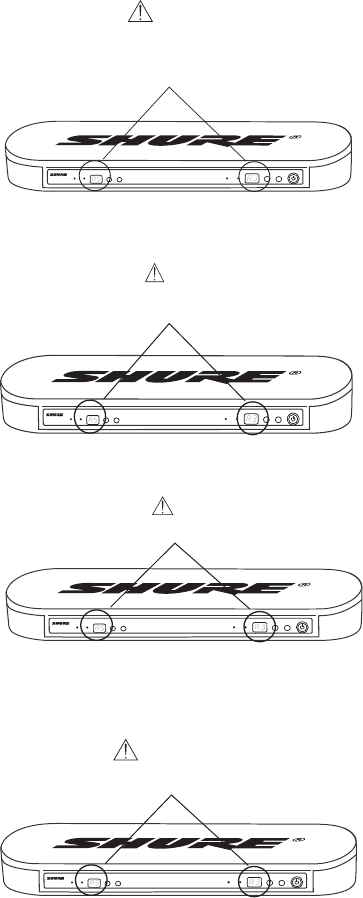
For proper operation, set each transmitter to
a different channel on the BLX88 receiver.
Caution
audio ready channel
Diversity Antenna System
PG4
audio ready group
(A-Y)
channel
(0-9)
BLX88
power
audio ready group
(A-Y)
channel
(0-9)
Consult your BLX Channel guide
to select compatible channel sets.
Pour un fonctionnement correct, régler chaque côté du récepteur double BLX88 sur
un canal différent.
Attention
Consulter le guide des canaux BLX pour sélectionner des jeux de canaux compatibles.
audio ready channel
Diversity Antenna System
PG4
audio ready group
(A-Y)
channel
(0-9)
BLX88
power
audio ready group
(A-Y)
channel
(0-9)
Para operação correta, ajuste cada lado do Receptor duplo BLX88 em um canal diferente.
Cuidado
Consulte o guia de Canal BLX para selecionar os ajustes de canais compatíveis.
audio ready channel
Diversity Antenna System
PG4
audio ready group
(A-Y)
channel
(0-9)
BLX88
power
audio ready group
(A-Y)
channel
(0-9)
Para el funcionamiento correcto, fije cada lado del receptor doble BLX88 en un canal
diferente.
Precaución
Consulte la guía de canales BLX para seleccionar los grupos de canales compatibles.
audio ready channel
Diversity Antenna System
PG4
audio ready group
(A-Y)
channel
(0-9)
BLX88
power
audio ready group
(A-Y)
channel
(0-9)
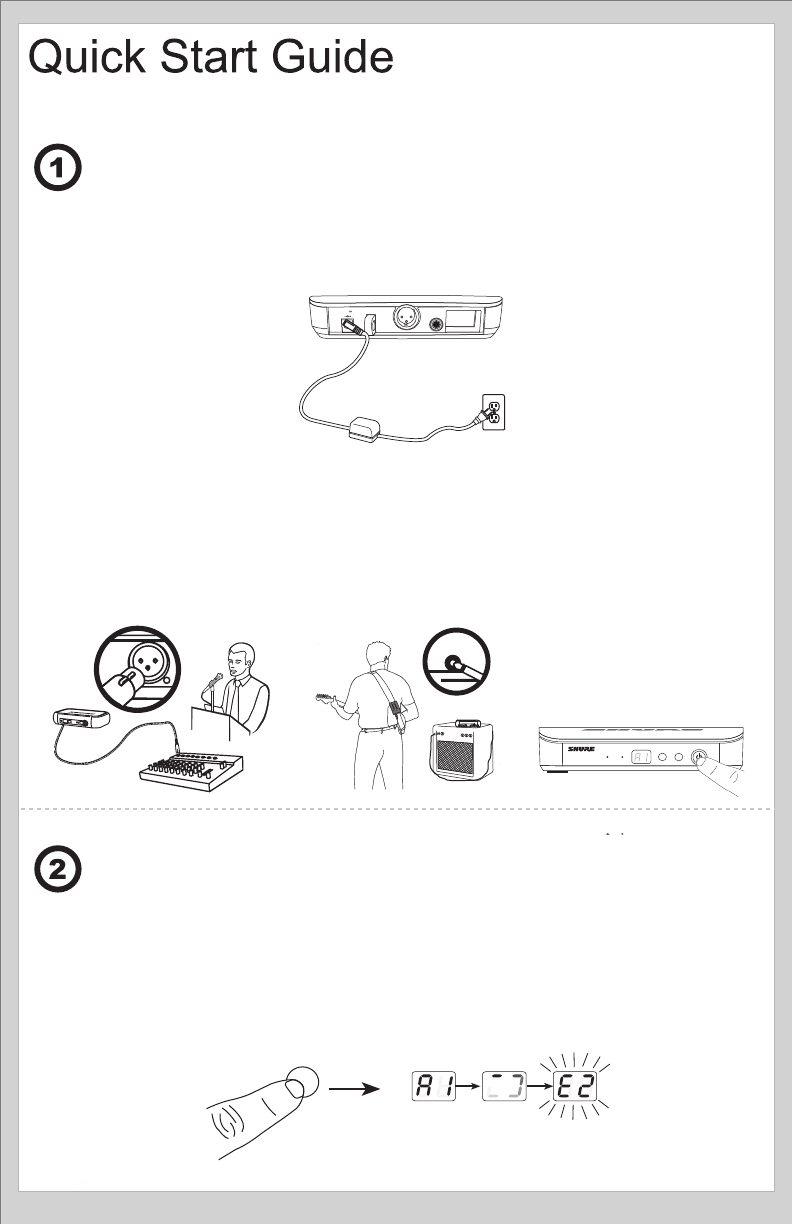
POWER
MIC OUT
INSTRUMENT OUT
12-18 V
160 mA
group
(A-Y)
Connect receiver to power source.
a)
b)
Press group button on receiver to
perform a group scan.
Connect receiver to mixer or amplifier.
Hold power button to turn on.
audio ready group
(A-Y)
channel
(0-9)
power
BLX4
Brancher le récepteur à une source
d'alimentation.
Brancher le récepteur à un mélangeur ou
un amplificateur. Appuyer sur le bouton
d'alimentation pour allumer le récepteur.
Appuyer sur le bouton group du
récepteur pour effectuer un balay-
age des groupes.
Den Empfänger an die
Stromversorgung anschließen.
Den Empfänger an das Mischpult oder
den Verstärker anschließen. Die Taste
power drücken, um den Empfänger
einzuschalten.
Am Empfänger die group-
Taste drücken, um einen
Gruppensuchlauf durchzuführen.
Conecte el receptor a la fuente de
alimentación.
Conecte el receptor a la mezcladora
o amplificador. Oprima el botón de ali-
mentación para encender el receptor.
Oprima el botón de grupo en el
receptor para realizar un escaneo
de grupo.
Collegate il ricevitore alla
presa di alimentazione.
Collegate il ricevitore al mixer o
all'amplificatore. Premete il pulsante
power per accendere il ricevitore.
Premete il pulsante group sul
ricevitore per eseguire una
ricerca del gruppo.
Conecte o receptor à fonte de
alimentação.
Conecte o receptor ao mixer ou ao
amplificador. Pressione o botão liga/
desliga para ligar o receptor.
Pressione o botão group no
receptor para executar uma
procura de grupo.
Подключите приемник к
источнику питания.
Подключите приемник к микшеру
или усилителю. Чтобы включить
приемник, нажмите кнопку Power.
Чтобы выполнить
сканирование групп,
нажмите на приемнике
кнопку Group.
受信機を電源に接続します。
受信機をミキサーまたはアンプに接
続します。電源ボタンを押して受信
機をオンにします。
受信機のグループボタンを押
して、グループスキャンを実
行します。
수신기를 전원에 연결합니다.
수신기를 믹서나 앰프에 연결합니다.
전원 버튼을 눌러 수신기를 켭니다.
그룹 스캔을 실행하려면 수신
기의 그룹 버튼을 누릅니다.
将接收机连接到电源。
将接收机连接到混音器或放大器。
按下电源按钮可打开接收机电源。
按下接收机上的组按钮,执行
组扫描。
Sambungkan receiver ke sum-
ber daya.
Sambungkan receiver ke mixer atau
amplifier. Tekan tombol daya untuk
menghidupkan receiver.
Tekan tombol grup pada re-
ceiver untuk memindai grup.
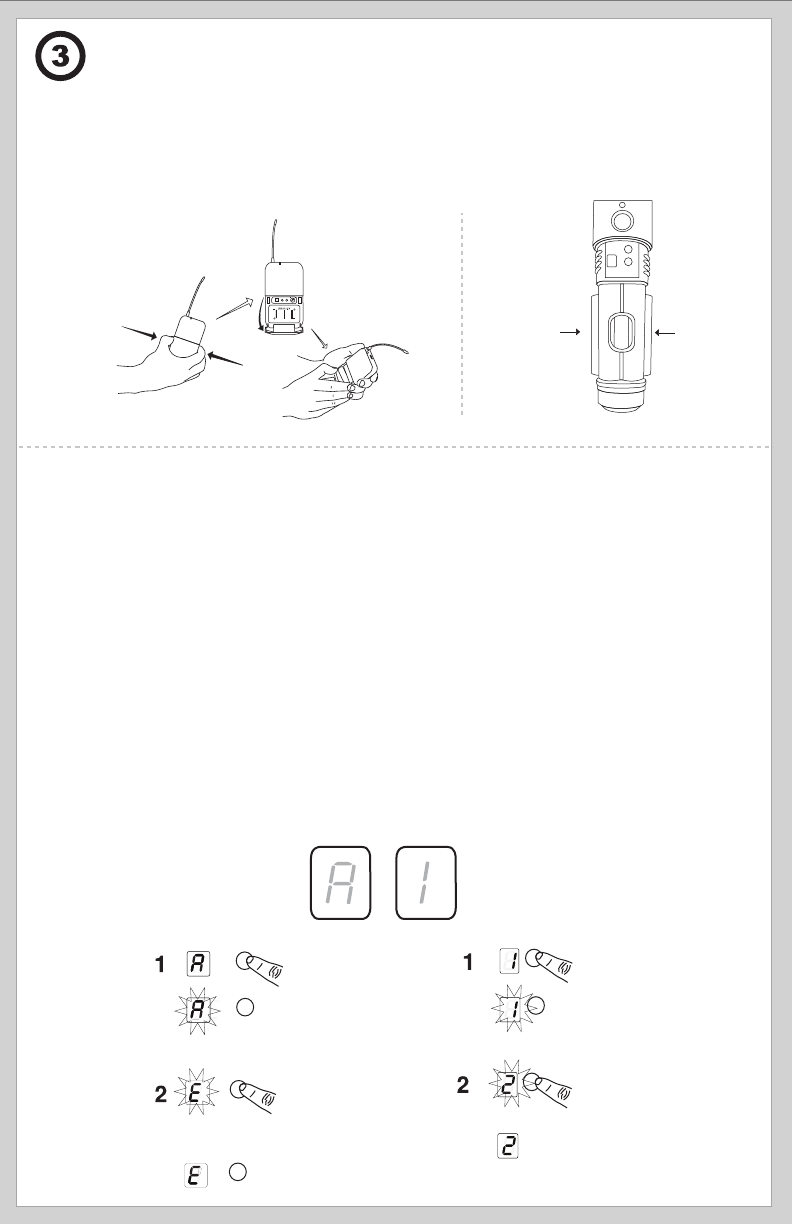
group
(A-Y)
channel
(0-9)
Install batteries and
turn on transmitter.
a)
b) On the transmitter, set the group and channel to
match the receiver. The audio LED on the receiver
should illuminate.
channel
group
group channel
channel
group
group
group channel
Installer les piles et
allumer l’émetteur.
Sur l'émetteur, régler le groupe et le canal afin
qu'ils correspondent à ceux du récepteur. Les
barres RF et la LED des piles du récepteur doi-
vent s'allumer.
Die Batterien/Akkus
einlegen und den
Sender einschalten.
Am Sender Gruppe und Kanal entsprechend
der Empfängereinstellung einstellen. Auf dem
Empfänger sollten die HF-Balken und Akku-LEDs
aufleuchten.
Instale las baterías
y encienda el
transmisor.
En el transmisor, seleccione el grupo y canal
para que coincidan con el receptor. Se deben
iluminar las barras de RF y el LED de batería en
el receptor.
Installate le pile ed ac-
cendete il trasmettitore.
Sul trasmettitore impostate il gruppo ed il canale
corrispondenti a quelli del ricevitore. Le barre RF
ed il LED della pila situati sul ricevitore devono
illuminarsi.
Instale as pilhas e ligue
o transmissor.
Ligue o transmissor e ajuste o grupo e o canal para
corresponder ao receptor. As barras de RF e o LED da
pilha no receptor devem acender.
Вставьте батарейки и
включите передатчик.
Установите на передатчике группу и канал для
согласования с настройкой приемника. На приемнике
должны загореться индикаторы интенсивности РЧ
сигнала и светодиод батарейки.
送信機に電池を入れ、
オンにします。
送信機で、グループとチャンネルを設定して受信機に合
わせます。受信機のRFバーと電池LEDが点灯します。
건전지를 설치한 다음 송
신기를 켜십시오.
송신기에 그룹과 채널을 설정하여 수신기에 일치시키십시오.
수신기의 RF 바와 건전지 LED에 불이 들어와야 합니다.
安装电池并打开发射机
电源。
在发射机上,将组和频道设置为与接收机匹配。接收机上的射频
指示灯条和电池指示灯应点亮。
Pasang baterai dan
hidupkan pemancar.
Pada pemancar, atur grup dan saluran untuk menyesuaikan
dengan receiver. Bilah FR dan lampu LED baterai pada re-
ceiver harus menyala.
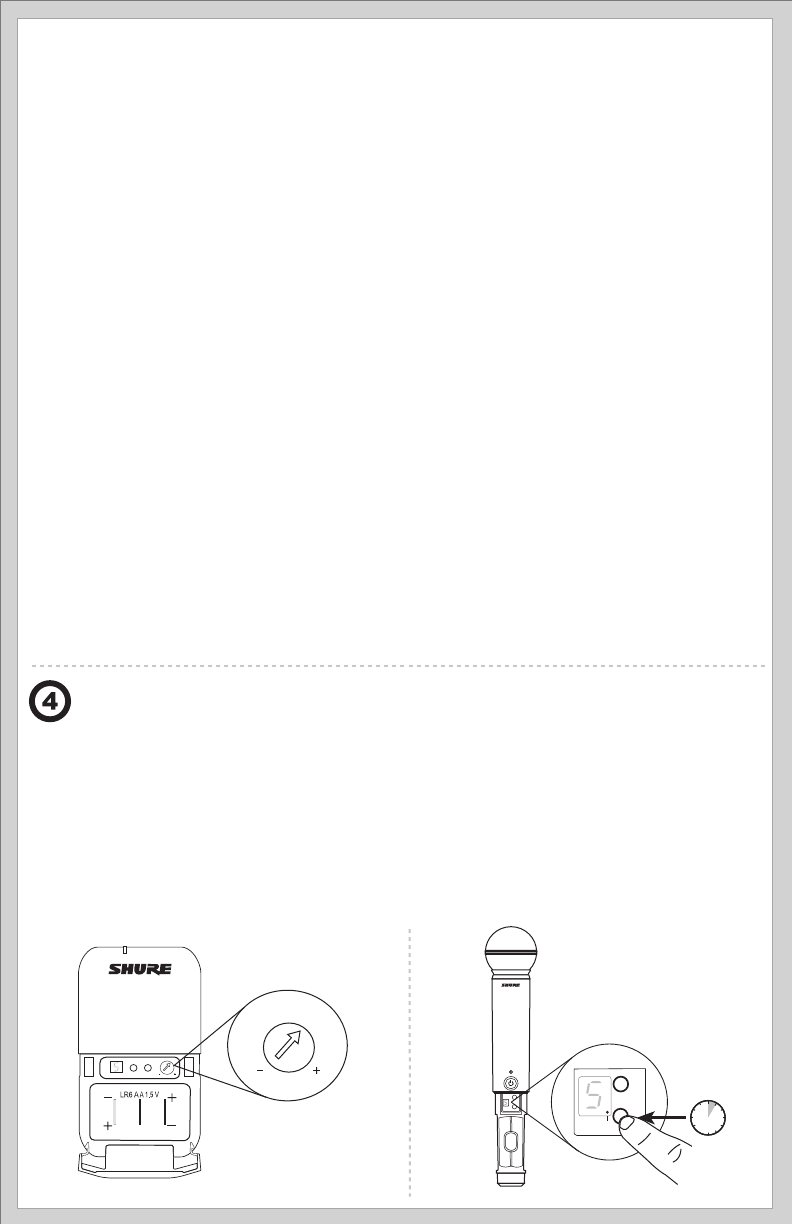
group
(A-Y)
channel
(0-9)
5 s
If sound is too faint or distorted,
adjust the gain accordingly.
If setting up additional systems, leave the first transmitter and receiver on. For each additional receiver, manually set the group to match
the first receiver.
Note: The receiver will automatically perform a channel scan to find an available frequency after the group has been selected. Set the
transmitter frequency to match the receiver.
channel group
-10 dB
-10 dB
channel group
Si l'on configure d'autres systèmes, laisser les premiers émetteur et récepteur allumés. Pour chaque système supplémentaire, régler
manuellement le groupe pour qu'il corresponde à celui du premier récepteur. Remarque : une fois le groupe sélectionné, le récepteur
exécutera automatiquement un scan des canaux afin de trouver une fréquence disponible. Régler la fréquence de l'émetteur pour
qu'elle corresponde à celle du récepteur.
Si le son est trop faible ou
distordu, régler le gain en
conséquence.
Falls weitere Systeme eingerichtet werden, den ersten Sender und Empfänger eingeschaltet lassen. Für jeden weiteren Empfänger die
Gruppe manuell auf den ersten Empfänger einstellen. Hinweis: Der Empfänger führt automatisch einen Kanalscan durch, um nach der
Auswahl der Gruppe eine verfügbare Frequenz zu finden. Die Senderfrequenz entsprechend der des Empfängers einstellen.
Falls der Ton zu schwach oder
verzerrt ist, die Verstärkung
dementsprechend korrigieren.
Si está configurando sistemas adicionales, deje encendidos el primer transmisor y receptor. Por cada receptor adicional, fije manual-
mente el grupo para hacerlo coincidir con el primer receptor. Nota: El receptor automáticamente realizará un escaneo de canales para
encontrar una frecuencia disponible después que se ha seleccionado el grupo. Fije la frecuencia del transmisor para que coincida con
el receptor.
Si el sonido es demasiado
débil o distorsionado, ajuste
la ganancia según sea
necesario.
Se impostate altri sistemi, lasciate accesi il primo trasmettitore e ricevitore. Per ciascun ricevitore aggiuntivo, impostate manualmente
il gruppo in modo che corrisponda al quello del primo ricevitore. Nota: all'avvenuta selezione del gruppo il ricevitore esegue automati-
camente una scansione del canale per individuare una frequenza disponibile. Impostate la frequenza del trasmettitore in modo che
corrisponda a quella del ricevitore.
Se il suono è troppo debole
o distorto, regolate il guad-
agno di conseguenza.
Ao configurar sistemas adicionais, deixe ligado o primeiro par de transmissor e receptor. Em cada receptor adicional, ajuste manu-
almente o grupo de acordo com o primeiro receptor. Observação: O receptor realizará automaticamente uma procura de canal para
encontrar uma frequência disponível após a seleção do grupo. Ajuste a frequência do transmissor de acordo com o receptor.
Se o som estiver muito fraco
ou distorcido, ajuste o ganho
conforme necessário.
Пр настройке дополнительных систем оставьте включенными первый передатчик и приемник. Для каждого дополнительного
приемника вручную установите группу, соответствующую первому приемнику. Примечание. После выбора группы приемник
автоматически выполнит сканирование каналов и найдет свободную частоту. Согласуйте частоты передатчика и приемника.
Если звук слишком
слабый или искажен,
подрегулируйте усиление.
追加システムを設定する場合は、最初の送信機と受信機をオンにした状態にしてください。各追加受信機ごとに、グループを手動で設
定して最初の受信機に合わせてください。注記:受信機は自動的にチャンネルスキャンを実行し、グループを選択したら利用可能な周
波数を検出します。送信機周波数を設定して受信機に一致させます。
音が小さすぎる場合や歪む
場合は、ゲインを適宜調整
してください。
추가 시스템을 설정하면 첫 번째 송신기와 수신기를 켠 상태로 두십시오. 각 추가 수신기마다 수동으로 첫 번째 송신기와 일치하는 그룹
을 설정하십시오. 주: 그룹이 선택되면 수신기가 자동으로 채널 스캔을 수행하여 사용 가능한 주파수를 찾습니다. 송신기 주파수를 수신
기에 일치시킵니다.
사운드가 너무 흐리거나 왜곡
된다면 게인을 조절하십시오.
如果要设置更多的系统,应让第一台发射机和接收机保持在打开状态。对于每个增加的接收机,因将组手动设置为与第一台接收机匹配。
注意:接收机可自动纸箱厂频道扫描,在选取组之后找到可用的频率。将发射机的频率设置为与接收机匹配。
如果声音太模糊或失真,应
相应地调节增益设置。
Jika mengatur sistem tambahan, biarkan pemancar dan receiver pertama hidup. Untuk setiap receiver tambahan, atur grup se-
cara manual untuk mencocokkan receiver pertama. Catatan: Receiver akan melakukan pemindaian saluran secara otomatis untuk
mendapatkan frekuensi yang tersedia setelah grup dipilih. Atur frekuensi pemancar untuk mencocokkan receiver.
Jika suara terlalu lemah atau
terdistorsi, sesuaikan pen-
guatan sesuai dengan itu.
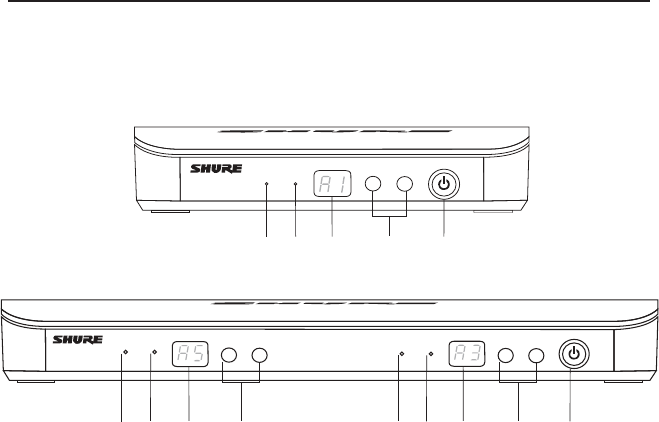
1
BLX
Features
Front Panel
① audio LED
Indicates strength of incoming audio signal: green for
normal and red for overload.
② ready LED
Green light indicates system is ready for use and
receiving transmitter signal.
③ LED Display
Displays group and channel setting.
④ group and channel Buttons
Scan: Push and release group button to scan for an
open group and channel.
Manual: Push and hold group button to select a
group. Push channel button to select a channel in the
current group.
⑤ power Button
Push and hold to turn power on or off.
BLX4
BLX88
audio ready group
(A-Y)
channel
(0-9)
power
BLX88
audio ready group
(A-Y)
channel
(0-9)
audio ready group
(A-Y)
channel
(0-9)
power
BLX4
⑤
① ② ③ ④
①②③ ④⑤
① ② ③ ④
English
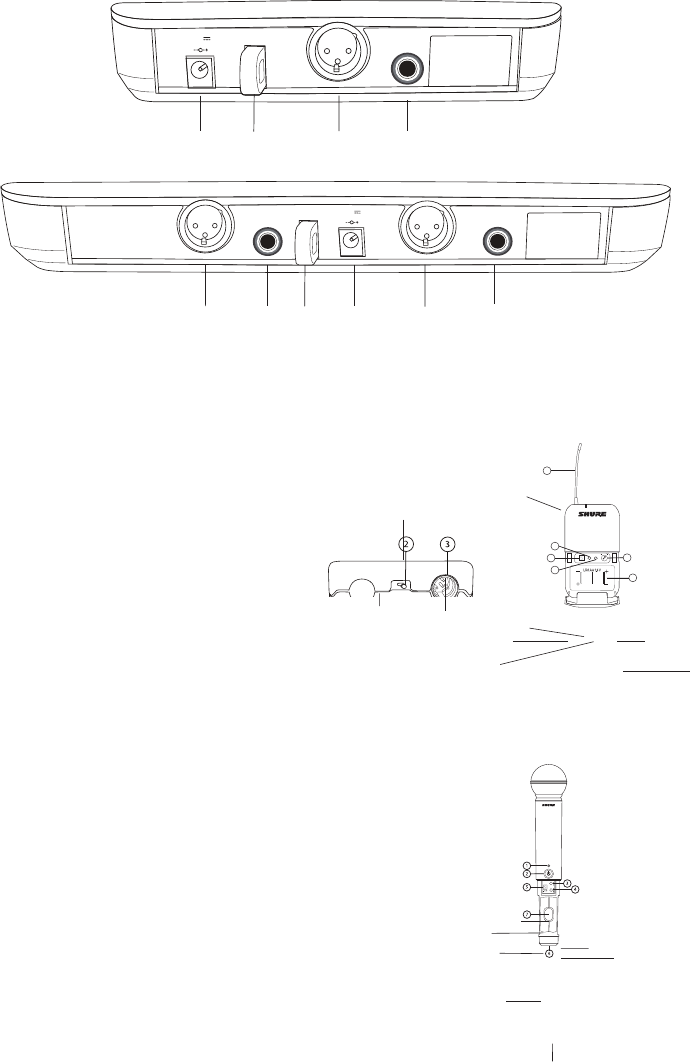
2
BLX2
Back Panel
① DC Power Jack
② Adapter Cord Tie-Off
③ XLR microphone output jack (MIC out)
④ 6.35 mm (1/4") instrument level output jack
(instrument out)
BLX1
① LED Indicator
Displays power and battery status (see
Transmitter LED Indicators).
② power Switch
Toggles power on or off.
③ 4-Pin Microphone Input Jack (TA4
connector)
④ Antenna
⑤ group Button
Changes group setting.
⑥ LED Display
Displays group and channel setting.
⑦ channel Button
Changes channel setting.
⑧ Battery Compartment
⑨ Audio Gain Adjustment
Rotate to increase or decrease transmitter gain.
BLX2
① LED Indicator
Displays power and battery status (see Transmitter LED Indicators).
② power Button
Push to turn power on or off.
③ group Button
Changes group setting.
④ channel Button
Changes channel and gain setting.
⑤ LED Display
Displays group and channel setting.
⑨
⑥ Identification Cap
⑦ Battery Compartment
BLX4
BLX88
BLX1
group
(A-Y)
channel
(0-9)
4
5
7
68
9
①
②④
⑤
⑥
⑦⑧
③
③ ④
⑥
⑦
⑤
①
②
POWER
MIC OUT
INSTRUMENT OUT
12-15 V
160 mA
①②③ ④
①
②③
③ ④④
POWER
MIC OUT
INSTRUMENT OUT
12-15 V
320 mA
INSTRUMENT OUT
MIC OUT
English
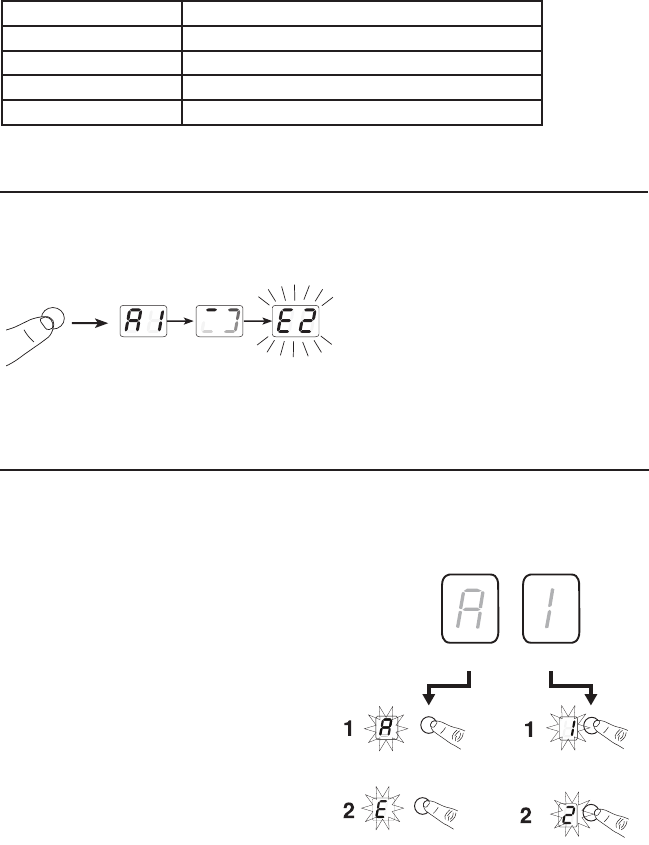
3
Transmitter LED Indicators
LED Indicator Status
Green Ready
Rapidly Flashing Red Controls locked
Solid Red Battery power low (less than 1 hour remaining*)
Flashing Red and shuts off Batteries dead (change batteries to power on transmitter)
*For alkaline batteries only. For rechargeable batteries, solid red means the batteries are dead.
Single System Set Up
group
(A-Y)
Setting Transmitter Group and Channel
Transmitter group and channel must be manually set to match the receiver.
Group (letter)
1. Press and release the group button on the transmitter
to activate the display. Press the group button again
and the display flashes.
2. While the display is flashing, press the group button
again to advance to the desired group setting.
Channel (number)
If channel needs to be changed, follow the same pro-
cedure using the channel button instead of the group
button.
Note:
• When the group and channel correctly match the
receiver, the ready LED on receiver illuminates.
• After manual setup, the transmitter alternately displays
the group and channel setting for about two seconds.
1. Press and release the group button on the receiver.
The receiver scans for the clearest group and
channel.
Note: If you want to stop the scan, push the group
button again.
2. Turn on transmitter and change the group and chan-
nel to match the receiver (See Setting Transmitter
Group and Channel).
Once the system is set up, perform an audio check and
adjust the gain if necessary.
Before you begin, turn off all transmitters and turn on any equipment (other microphones or personal monitoring systems)
that could cause interference during the performance.
channel
group
channel
group
group channel
x 2 x 2
English

4
Multiple System Setup
Up to 12 systems can operate simultaneously (band and RF environment dependent).
Important: Set up each system one-at-a-time. Once a receiver and transmitter are tuned to the same group and channel,
leave the transmitter powered on. Otherwise, scans from the other receivers will not detect that channel as occupied. For
the BLX88, be sure to setup both transmitters before progressing to the next receiver.
Turn on any other equipment that could cause interference during the performance so it will be detected during the group
and channel scans in the following steps.
Before you begin system set up, turn all receivers ON and all transmitters OFF.
For the first receiver:
1. Perform a group scan.
This finds the group with the most clear channels.
Note: For the BLX88, the group scan sets up both receivers at the same time.
2. Turn on the first transmitter and change the group and channel to match receiver.
3. Leave the transmitter on and continue with the additional systems.
Note: If the selected group does not contain enough open channels, manually select group "d" when setting up larger
systems.
For each additional receiver:
1. Use manual setup to change the receiver to match the group setting of the first receiver. Recall that each time the
group setting is changed, a channel scan is automatically done.
2. Turn on the transmitter and change the group and channel to match the receiver.
3. Leave the transmitter on and continue to the next system.
4. Once all receivers are set up, perform an audio check on all microphones.
Manually Setting Receiver Group and Channel
The receiver group may need to be changed as part of a multiple system setup.
Group (letter)
1. Hold the group button on the receiver until the display begins to flash.
2. While the display is flashing, press the group button again to advance to the next group.
Note: Only the group setting will be displayed during the manual setup.
3. Once the desired group is reached, release the group button. The receiver automatically performs a channel scan.
Channel (number)
Always use a channel selected by the channel scan. However, if necessary, the channel can be set manually. Follow the
same steps above using the channel button instead of the group button.
Locking and Unlocking Controls
Lock system controls to prevent accidental setting changes or power off.
Transmitter (lock/unlock)
Turn the transmitter on. Hold the group button, then press
the channel button for approximately 2 seconds. The
LED indicator rapidly flashes red when locked.
Receiver (lock/unlock)
Turn the receiver on. Simultaneously hold the group and
channel button. The display flashes rapidly.
• When locked, the display flashes rapidly if any key is
pressed.
• The BLX88 locks on both sides when locked from
either side.
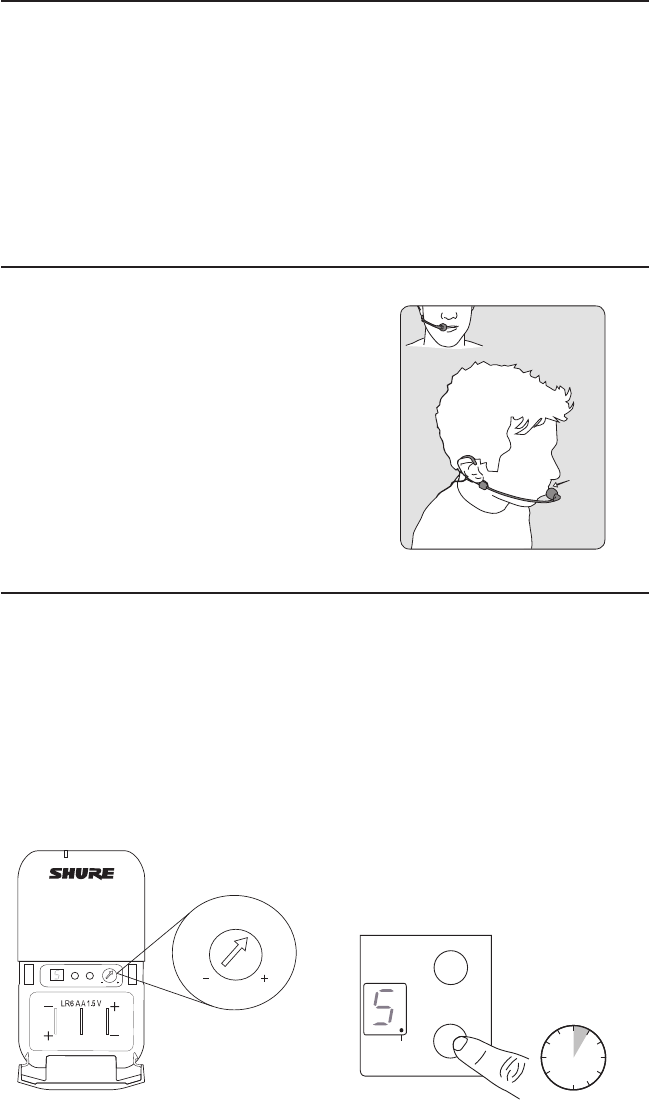
5
Getting Good Sound
Wearing the Headworn Microphone
• Position the headworn microphone 13 mm (1/2 in.)
from the corner of your mouth.
• Position lavalier and headworn microphones so that
clothing, jewelry, or other items do not bump or rub
against the microphone.
Tips to Improve Wireless System Performance
If you encounter interference or dropouts, try the following suggestions:
• Choose a different receiver channel
• Reposition the receiver so there is nothing obstructing a line of sight to the transmitter (including the audience)
• Avoid placing transmitter and receiver where metal or other dense materials may be present
• Move the receiver to the top of the equipment rack
• Remove nearby sources of wireless interference, such as cell phones, two-way radios, computers, media players, Wi-
Fi devices, and digital signal processors
• Charge or replace the transmitter battery
• Keep transmitters more than two meters (6 feet) apart
• Keep the transmitter and receiver more than 5 meters (16 feet) apart
• During sound check, mark trouble spots and ask presenters or performers to avoid those areas
Correct Microphone Placement
• Hold the microphone within 12 inches from the sound
source. For a warmer sound with increased bass
presence, move the microphone closer.
• Do not cover grille with hand.
Adjusting Gain
Monitor the audio LED indicator on the receiver front panel when setting the transmitter gain.
• Green: normal levels
• Red: excessive sound levels (overload).
The red LED should only illuminate infrequently when you speak loudly or play your instrument loudly.
BLX1
Rotate the audio gain adjustment to increase (+) or de-
crease (−) the gain until desired level is reached.
For instruments, turn gain to minimum setting. For lava-
liers, increase the gain as desired.
BLX2
The BLX2 features two gain level settings, default and
attenuated (-10 dB). The default setting is used for most
situations. If the receiver audio LED flickers red often, set
the microphone to attenuated. Use the channel button to
change the gain setting.
1. Hold down the channel button for 5 seconds.
A dot appears on the lower right-hand corner of the
LED display, which indicates −10 dB gain setting has
been activated.
2. To change the gain back to default, hold the channel
button again for 5 seconds, or until the dot disappears.
13 mm
(.5 in.)
group
(A-Y)
channel
(0-9)
channel group
-10 dB
select
5 s
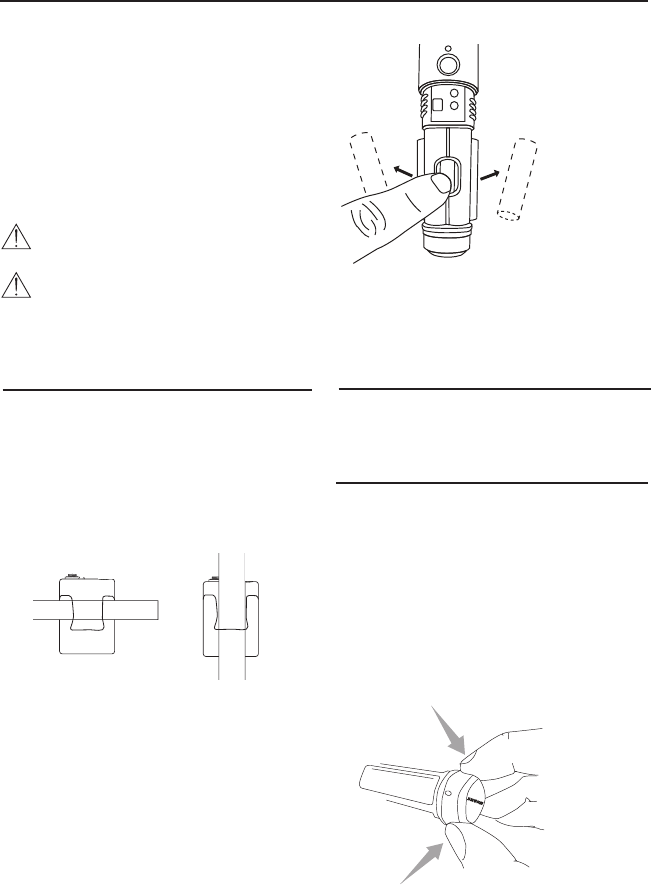
6
Batteries
Expected life for AA batteries is up to 14 hours (total
battery life varies depending upon battery type and
manufacturer).
When the LED indicator turns red, it signifies "low battery"
with approximately 60 minutes of remaining battery life.
For alkaline batteries only. For rechargeable batteries,
solid red means the batteries are dead.
To remove batteries from the handheld transmitter, push
them out through the opening in the microphone battery
compartment.
WARNING: Danger of explosion if battery
incorrectly replaced. Operate only with Shure
compatible batteries.
WARNING: Battery packs shall not be exposed
to excessive heat such as sunshine, fire, or
the like.
Wearing the Bodypack
Transmitter
Clip the transmitter to a belt or slide a guitar strap through
the transmitter clip as shown.
For best results, the belt should be pressed against the
base of the clip.
Power Off
Hold down the power button to power off the BLX2 or
BLX4/88. To power off the BLX1, slide the power toggle
switch to OFF.
Removing and Installing
Identification Caps
The BLX2 is equipped with a black identification cap from
the factory (dual vocal systems ship with additional gray
cap).
To remove: Remove battery cover. Squeeze sides and
pull off cap.
To install: Align the cap and click into place. Replace
battery cover.
An Identification Cap Kit containing assorted colored caps
is available as an optional accessory.

7
Troubleshooting
Issue Indicator Status Solution
No sound or faint sound Receiver ready LED on • Verify all sound system connections or adjust gain
as needed (see Adjusting Gain)
• Verify that the receiver is connected to mixer/
amplifier
Receiver ready LED off • Turn on transmitter
• Make sure the batteries are installed correctly
• Perform transmitter setup (see Single System
Setup)
• Insert fresh batteries
Receiver LED screen off • Make sure DC adapter is securely plugged into
electrical outlet.
• Make sure receiver is powered on.
Transmitter indicator LED
flashing red
Replace transmitter batteries (see Changing
Batteries).
Audio artifacts or dropouts Ready LED flickering or off • Change receiver and transmitter to a different
group and/or channel.
• Identify nearby sources of RF interference, and
shutdown or remove source.
• Replace transmitter batteries.
• Ensure that receiver and transmitter are positioned
within system parameters
• System must be set up within recommended range
and receiver kept away from metallic surfaces.
• Transmitter must be used in line of sight from re-
ceiver for optimal sound
Distortion Audio LED on receiver indi-
cates overload (red)
Reduce transmitter gain (see Adjusting Gain).
Sound level variations when
switching to different sources
N/A Adjust transmitter gain as necessary (see Adjusting
Gain).
Receiver/transmitter won't
turn off
LED/display flashing rapidly See Locking and Unlocking Controls.

8
BLX
BLX1
BLX2
Audio Input Level
gain 0dB -20 dBV maximum
-10dB -10 dBV maximum
Gain Adjustment Range
10 dB
RF Transmitter Output
10 mW, typical
varies by region
Dimensions
224 mm X 53 mm dia. (8 7/8 X 2 1/8 in.)
Weight
218 g (7.7 oz.) (without batteries)
Housing
Molded ABS
Power Requirements
2 LR6 AA batteries, 1.5 V, alkaline
Battery Life
up to 14 hours (alkaline)
Working Range
91 m (300 ft) Line of Sight
Note: Actual range depends on RF signal absorption, reflection and
interference.
Audio Frequency Response
50 to 15,000 Hz
Note: Dependent on microphone type
Total Harmonic Distortion
Ref. ±33 kHz deviation with 1 kHz tone
0.5%, typical
Dynamic Range
100 dB, A-weighted, typical
Operating Temperature
-18°C (0°F) to 57°C (135°F)
Note: Battery characteristics may limit this range.
Polarity
Positive pressure on microphone diaphragm (or positive
voltage applied to tip of WA302 phone plug) produces
positive voltage on pin 2 (with respect to pin 3 of low-
impedance output) and the tip of the 1/4-inch output.
Audio Input Level
gain max -16 dBV maximum
min (0 dB) +10 dBV maximum
Gain Adjustment Range
26 dB
Input Impedance
1 MΩ
RF Transmitter Output
10 mW, typical
varies by region
Dimensions
110 mm x 64 mm x 21 mm (H x W x D)
Weight
75 g (2.6 oz.), without batteries
Housing
Molded ABS
Power Requirements
2 LR6 AA batteries, 1.5 V, alkaline
Battery Life
up to 14 hours (alkaline)
BLX4 & BLX88
Output Impedance
XLR connector 200 Ω
6.35 mm (1/4") connector 50 Ω
Audio Output Level
Ref. ±33 kHz deviation with 1 kHz tone
XLR connector –27 dBV (into 100 kΩ
load)
6.35 mm (1/4") connector –13 dBV (into 100 kΩ
load)
RF Sensitivity
-105 dBm for 12 dB SINAD, typical
Image Rejection
>50 dB, typical
Dimensions
BLX4 40 mm X 188 mm X 103 mm (H x W x D)
BLX88 40 mm X 388 mm X 116 mm (H x W x D)
Weight
BLX4 241 g (8.5 oz.)
BLX88 429 g (15.1 oz.)
Housing
Molded ABS
Power Requirements
12–15 V DC @ 160 mA (BLX88, 320 mA), supplied by
external power supply (tip positive)

9
BLX1, BLX2
Certified under FCC Part 74.
Certified by IC in Canada under RSS-123 and RSS-102.
FCC ID: DD4BLX1A, DD4BLX1B, DD4BLX1C,
DD4BLX1D; DD4BLX2A, DD4BLX2B, DD4BLX2C,
DD4BLX2D, DD4BLX1W, DD4BLX1S, DD4BLX2W,
DD4BLX2S. IC: 616A-BLX1A, 616A-BLX1B,
616A-BLX1C, 616A-BLX1D; 616A-BLX2A, 616A-BLX2B,
616A-BLX2C, 616A-BLX2D
Certified by IC in Canada under RSS-102 and RSS-210.
IC: 616A-BLX1W, 616A-BLX1S, 616A-BLX2W,
616A-BLX2S
BLX4, BLX88
Approved under the Declaration of Conformity (DoC) pro-
vision of FCC Part 15.
Certifications
This product meets the Essential Requirements of all rel-
evant European directives and is eligible for CE marking.
The CE Declaration of Conformity can be obtained from
Shure Incorporated or any of its European representatives.
For contact information please visit www.shure.com
The CE Declaration of Conformity can be obtained from:
www.shure.com/europe/compliance
Authorized European representative:
Shure Europe GmbH
Headquarters Europe, Middle East & Africa
Department: EMEA Approval
Jakob-Dieffenbacher-Str. 12
75031 Eppingen, Germany
Phone: 49-7262-92 49 0
Fax: 49-7262-92 49 11 4
Email: info@shure.de
Important Product Information
LICENSING INFORMATION
Licensing: A ministerial license to operate this equipment
may be required in certain areas. Consult your national
authority for possible requirements. Changes or modifica-
tions not expressly approved by Shure Incorporated could
void your authority to operate the equipment. Licensing
of Shure wireless microphone equipment is the user’s
responsibility, and licensability depends on the user’s clas-
sification and application, and on the selected frequency.
Shure strongly urges the user to contact the appropriate
telecommunications authority concerning proper licensing,
and before choosing and ordering frequencies.
Information to the user
This equipment has been tested and found to comply with
the limits for a Class B digital device, pursuant to Part 15
of the FCC Rules. These limits are designed to provide
reasonable protection against harmful interference in a
residential installation. This equipment generates uses and
can radiate radio frequency energy and, if not installed
and used in accordance with the instructions, may cause
harmful interference to radio communications. However,
there is no guarantee that interference will not occur in a
particular installation. If this equipment does cause harmful
interference to radio or television reception, which can be
determined by turning the equipment off and on, the user
is encouraged to try to correct the interference by one or
more of the following measures:
• Reorient or relocate the receiving antenna.
• Increase the separation between the equipment and
the receiver.
• Connect the equipment to an outlet on a circuit
different from that to which the receiver is connected.
• Consult the dealer or an experienced radio/TV
technician for help.
This device complies with Industry Canada licence-exempt
RSS standard(s). Operation of this device is subject to the
following two conditions: (1) this device may not cause
interference, and (2) this device must accept any interfer-
ence, including interference that may cause undesired
operation of the device.
Le présent appareil est conforme aux CNR d'Industrie
Canada applicables aux appareils radio exempts de
licence. L'exploitation est autorisée aux deux conditions
suivantes : (1) l'appareil ne doit pas produire de brouillage,
et (2) l'utilisateur de l'appareil doit accepter tout brouillage
radioélectrique subi, même si le brouillage est susceptible
d'en compromettre le fonctionnement.
This device operates on a no-protection no-interference
basis. Should the user seek to obtain protection from other
radio services operating in the same TV bands, a radio
licence is required. Please consult Industry Canada's
document CPC-2-1-28, Optional Licensing for Low-Power
Radio Apparatus in the TV Bands, for details.
Industry Canada ICES-003 Compliance Label: CAN
ICES-3 (B)/NMB-3(B)
Note: EMC conformance testing is based on the use of
supplied and recommended cable types. The use of other
cable types may degrade EMC performance.
Changes or modifications not expressly approved by
the manufacturer could void the user’s authority to
operate the equipment.
Please follow your regional recycling scheme for batteries,
packaging, and electronic waste.
Australia Warning for Wireless
This device operates under an ACMA class licence and
must comply with all the conditions of that licence includ-
ing operating frequencies. Before 31 December 2014,
this device will comply if it is operated in the 520-820 MHz
frequency band. WARNING: After 31 December 2014, in
order to comply, this device must not be operated in the
694-820 MHz band.

10
Frequency Range and Transmitter
Output Level
Band Range Output
Power
H8 518 to 542 MHz 10 mW
H8E 518 to 542 MHz 10 mW
H9 512 to 542 MHz 10 mW
H10 542 to 572 MHz 10 mW
J10 584 to 608 MHz 10 mW
K3E 606 to 630 MHz 10 mW
K12 614 to 638 MHz 10 mW
K14 614 to 638 MHz 10 mW
M15 662 to 686 MHz 10 mW
M17 662 to 686 MHz 10 mW
Q25 742 to 766 MHz 10 mW
R12 794 to 806 MHz 10 mW
S8 823 to 832 MHz 10 mW
T11 863 to 865 MHz 10 mW
NOTE: This Radio equipment is intended for use in musi-
cal professional entertainment and similar applications.
This Radio apparatus may be capable of operating on
some frequencies not authorized in your region. Please
contact your national authority to obtain information on
authorized frequencies and RF power levels for wireless
microphone products.

PERU DECLARATION OF CONFORMITY
Shure Incorporated
5800 W. Touhy Avenue
Niles, Illinois 60714-4608, U.S.A.
(847) 600-2000
Shure Incorporated declares that the following product
Model: BLX1-H8E (518 – 542 MHz) BLX1-K3E (606 – 630 MHz)
Description: UHF FM Wireless Microphone Transmitter
Has been tested and found to comply with the limits set in Peru wireless regulatory
standard RM N
°
204-2009-MTC/03. It’s effective radiated power (ERP) has been
measured to be less than 10 mW, as measured in accordance with ETSI standard EN 300
422.
Signed __________________________________ Date: May 16, 2012
Name, Title: Alex Chung, Sr. Manager, Global Compliance, Shure Incorporated
Shure Incorporated declares that the following product
Model: BLX2-H8E (518 – 542 MHz) BLX2-K3E (606 – 630 MHz)
Description: UHF FM Wireless Microphone Transmitter
Has been tested and found to comply with the limits set in Peru wireless regulatory
standard RM N
°
204-2009-MTC/03. It’s effective radiated power (ERP) has been
measured to be less than 10 mW, as measured in accordance with ETSI standard EN 300
422.
Signed __________________________________ Date: May 16, 2012
Name, Title: Alex Chung, Sr. Manager, Global Compliance, Shure Incorporated
PERU DECLARATION OF CONFORMITY
Shure Incorporated
5800 W. Touhy Avenue
Niles, Illinois 60714-4608, U.S.A.
(847) 600-2000
